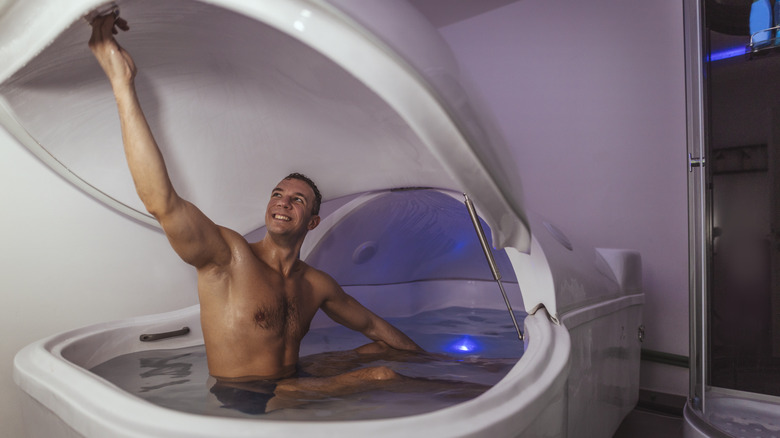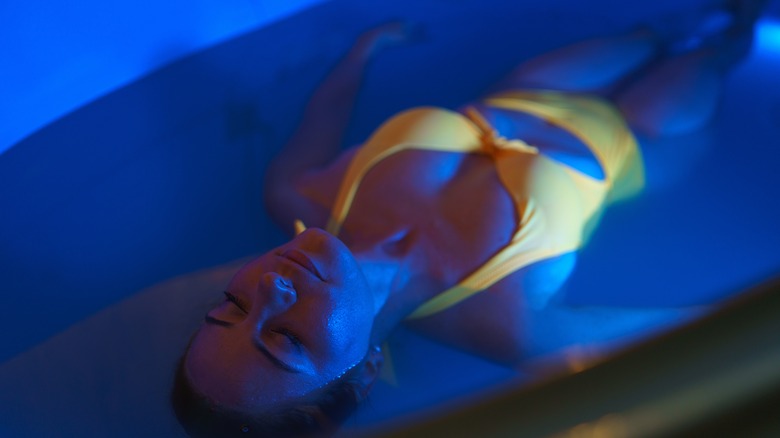Everything You Need To Know About Float Tanks
There are many ways to relax during your day. Reading a book, taking a hot bath, going to the gym, listening to music, or doing yoga and practicing meditation can help you feel better physically and mentally. Another option to clear your mind? Float for a few hours in salt water. But wait, there's no need to visit the Dead Sea for that; a float tank will be enough.
Also known as sensory deprivation tank therapy, float tanks are becoming increasingly popular as they are believed to provide many health and wellness benefits. According to WebMD, they aid in relaxation, provide migraine and stress relief, and detoxify the body.
If you have a fast-paced lifestyle, now is the perfect time to slow down and take a break to take care of yourself. Leaving you alone with your thoughts and depriving you of your five senses, float tanks are a unique type of wellness treatment (per Urban Float). Ready to take the plunge? From what to wear and what to expect, to how the experience affects your brain, here's everything you need to know about float tanks.
What are float tanks?
If you've never seen a float tank, you may be picturing an ultra-connected futuristic machine in your mind. But most tanks are simple, egg-shaped cocoon-like capsules that are surprisingly easy to use. These soundproof, pitch-black tanks are filled with water that is heated at the same temperature as the human body. 1,000+ pounds of Epsom salts are added to allow your body to achieve full buoyancy (via Salt7Even Float Center). The high concentration of salts also makes for a sterile environment. Once inside, you'll be able to effortlessly relax deeply as you experience true weightlessness.
Float tanks were first developed in the '50s as a means to explore various states of consciousness (via BBC). Controversial neuropsychiatrist John C. Lilly was the first to study the effects of sensory deprivation in float tanks, but because he had long been interested in psychedelic drugs and dolphin communication, his research was not taken seriously. Today, there is growing research into the health and wellness benefits of float tanks.
What are the benefits of float tanks?
The weightless sensation you will experience during a float tank session will allow your muscles and joints to relax completely and will help you fight chronic pain. "By not really touching a hard surface, it helps complete that feeling of disconnect," integrative medicine specialist Dr. Irina Todorov told Cleveland Clinic. Additionally, the water is maintained at 98.6 degrees, the average temperature of the human body, and the air is set to about 86 degrees. Because your body doesn't need to exert energy to heat itself, your muscles are able to release their tension.
A float tank session can also provide a mental boost. According to a study published in the Journal of Environmental Psychology, floating stimulates creativity and concentration. This can be due to an increase in EEG alpha wave activity in the brain. "Alpha frequency band is sensitive to various creativity-related demands involved in creative ideation," describes the study published in Neuroscience & Biobehavioral Reviews (via National Library of Medicine).
In addition, float tanks also help reduce anxiety and stress, improve the quality of your sleep, and make you feel happier and calmer, according to a study published in BMC Complementary Medicine and Therapies (via National Library of Medicine).
What is sensory deprivation?
Getting into a float tank feels like entering a new dimension where time stands still and the world disappears around you. All your senses just vanish as you are plunged into the dark, alone, in the silence. No sense can distract you anymore. Nothing can disturb your experience, not even the tiny air bubble coming from the filter or the slightest vibration in the tank. "We're kind of designed to pay attention to all the stimuli around us, and what catches our attention more than anything is change," Roderick Borrie, a psychologist based in New York City, tells Mental Floss. "What happens when there's almost no change? Then the mind slows down."
According to some studies, the lack of external stimuli can be referred to as a "psychedelic experience." And while some people have reported that sensory deprivation leads to hallucinations, experts at The Floating Blog say the floating sessions are typically not long enough to allow your brain to experience visions, unless you are already prone to hallucinations (per North West Float Center).
For others, the experience of floating is a new beginning. In a study published in PLoS One, one adult participant who had been diagnosed with mental health disorders said, "I felt completely refreshed like my mind and body had been reset," (via National Library of Medicine).
How does a floating tank impact your brain?
Your brain is a real machine that works 24/7, yet it doesn't work the same way when you sleep, work out, or relax. "While we normally only use 11% of our total brainpower, a session in the float tank enables us to tap into the other 89% previously unreachable source of creativity" explains a study in the European Journal of Integrative Medicine (via ScienceDirect).
You're constantly using your five senses, thus the brain is always working to analyze what you smell, see, touch, and hear. In a float tank, however, none of the senses are used anymore. This deprivation of sensory stimulation erases your body's limits, and also has positive effects on your mood. Graham Talley, the owner of a float tank center in Portland tells Buffer that "your brain releases elevated levels of dopamine," which is a chemical that influences feelings of pleasure.
In addition, during a float, your brain can enter a different wave frequency called theta, which is close to the meditative state (via Medium). This state is ideal for rejuvenation, as well as learning, and exploring your imagination and creativity. These effects will last a couple of days after your session, so you'll be able to enjoy that "post-float glow" for longer.
How to get the most from your float
An hour may seem like a long time in some situations, but when you're disconnected from reality it can fly by quickly. To float better and make the most of your time in the tank, focus on your breathing. This will leave your body in a completely relaxed state, which will have an impact on the results you'll get after the session. If you want to feel much more comfortable when floating, start your pre-session by doing some relaxation exercises for 10 to 15 minutes (via True Rest Float Spa). You can perform yoga postures, meditate, or stretch to prepare your body for anti-gravity.
When floating, try not to move too much, stay as still as possible to completely forget you have a body. Other key tips include having confidence and trusting the process and the water that will carry you during your journey. If you feel stressed, the floating therapy will produce the opposite effect.
Finally, because the human body is composed of 60% water (per Otsuka), and float tank therapy is a detoxifying experience, don't forget to drink water before and after each session so your body doesn't get dehydrated.
Myths about float tanks
If you're still hesitant to float, it may be because of the myths you may have heard about this wellness experience. If you think it's dangerous to sleep in the tank, rest assured your head won't roll to the side and cause you to drown (per WebMD). In fact, even if you fall asleep, your body will not change position. But if you prefer to float on your side, most spas have specialized cushions available for this purpose.
Wonder what happens to the water? While the Epsom salts in the water naturally create an environment where bacteria cannot live, reputable float centers also take extra precautions to ensure their water is sterile and safe to float in.
Water is typically sanitized with a disinfectant and a UV light, as well as filtered between each session. "We start by filtering the entire amount of water through a cartridge filter (one-micron cartridge) in each tank four to five times between each user to pull out any organic impurities," experts at Float North County said.
Who shouldn't float?
If you're eager to test out this unique experiment, you should know that not everyone can float. If you have open wounds or tattoos and piercings that aren't fully healed, you should not book a float session. Other cosmetic enhancements will be affected as well. Henna tattoos will be completely washed away, so, if possible, remove them before your session. If your hair is dyed, a float may cause your hair color to fade.
If you have inflammation, such as an ear infection or sensitive skin, it's best not to indulge in this wellness method as it may cause more problems for you than it solves. If you have bladder control issues, are on your period, or have shaved in the last 24 hours, spa centers encourage you to postpone your appointment. And if a baby is on the way, you may still be able to float, but there are steps to take beforehand. Mandy Rowe, director at True REST Float Spa told Shape that she "encourages pregnant women to float as it can help with muscle aches and pains, but highly encourages them to speak with their doctors before trying."
Finally, if the idea of being locked up for several hours in the dark gives you goosebumps, you may be claustrophobic, and floating therapy likely will not be the relaxing experience for you as it is for others (via The Floatasium). If you need to center yourself, try deep breathing techniques instead.
How often should you float?
Your floating therapy session works in the same way as a weekly workout, so consistency is key. Even though you will see positive effects on your body and mind from the very first session, you should know that the more you float, the better you'll feel. The more you are in contact with water, and the more weightless you are, the more your body will take in the magnesium contained in the Epsom salt to provide your body with numerous health benefits. Better sleep, and reduced muscle and bone pain are all advantages of floating therapy that will be seen over time. Patience and regularity are crucial when opting for natural remedies.
Peak Performance Float and Wellness Center recommends one float a week for six weeks to start, and then schedule more frequent appointments as needed. Be aware that you will feel more and more comfortable after each session, so the first one will not be the most intense. The brain needs time to get familiar with the new experience and feelings.
Your lifestyle will also inevitably impact the frequency of your sessions. As seen previously, being on your period or having freshly dyed hair can affect the timing of appointments. And you still need to budget for floating therapy. The price of a one-hour session varies from $30 to $250, depending on the center, according to Dr. Axe.
What should you bring to your float therapy session?
In order to take full advantage of this incomparable body relief, it's better to be well-prepared. If you are new to floating, you have probably wondered what to bring to your session. Some accessories are provided by the spa, to offer more comfort to customers, and for hygiene reasons. You can expect to find earplugs, towels, soap, and shampoo available at check-in. However, nothing prevents you from bringing your own accessories if you'd rather use your own.
Some additional items you may want to remember to bring include face and body moisturizer, a hairbrush, hair ties if you have long hair, makeup remover (pre-float), and makeup (post-float, if desired). If you wear contacts, it can be useful to bring your contact case to store them in since you won't be allowed to wear them in the float tank. If you decide to go for a winter float, also bring warm clothes such as a scarf and a hat so you don't catch a cold when you leave the spa (per Longevity Effect).
If you like to read you can also bring a book as many centers have a lounge where you can continue to relax after your session. And don't forget to bring your good mood and excitement!
What should you wear in the float tank?
The float tank experience is a unique one, which is why it's wise to bring an appropriate outfit in order to enjoy this time of recharging your batteries. During a float, it's recommended to remove all distractions, including clothing and any hair accessories. If you are distracted in any way, your mind will focus directly on these elements and reduce the beneficial effects of sensory deprivation (per Vessels Floats).
In most centers, the tank is located in a room that is completely yours during your session. Therefore, you can be clothing-free and float completely naked so as not to be distracted by any other sensation. Because your privacy is maintained at all times, becoming one with your body and having no distractions from clothing is the best way to enjoy the session 100%. However, if you are not comfortable with nudity, it's best if you wear something close to your body, such as a swimsuit (per Longevity Effect).
Long story short, just bring yourself, and you will be ready to start your float tank therapy journey.










